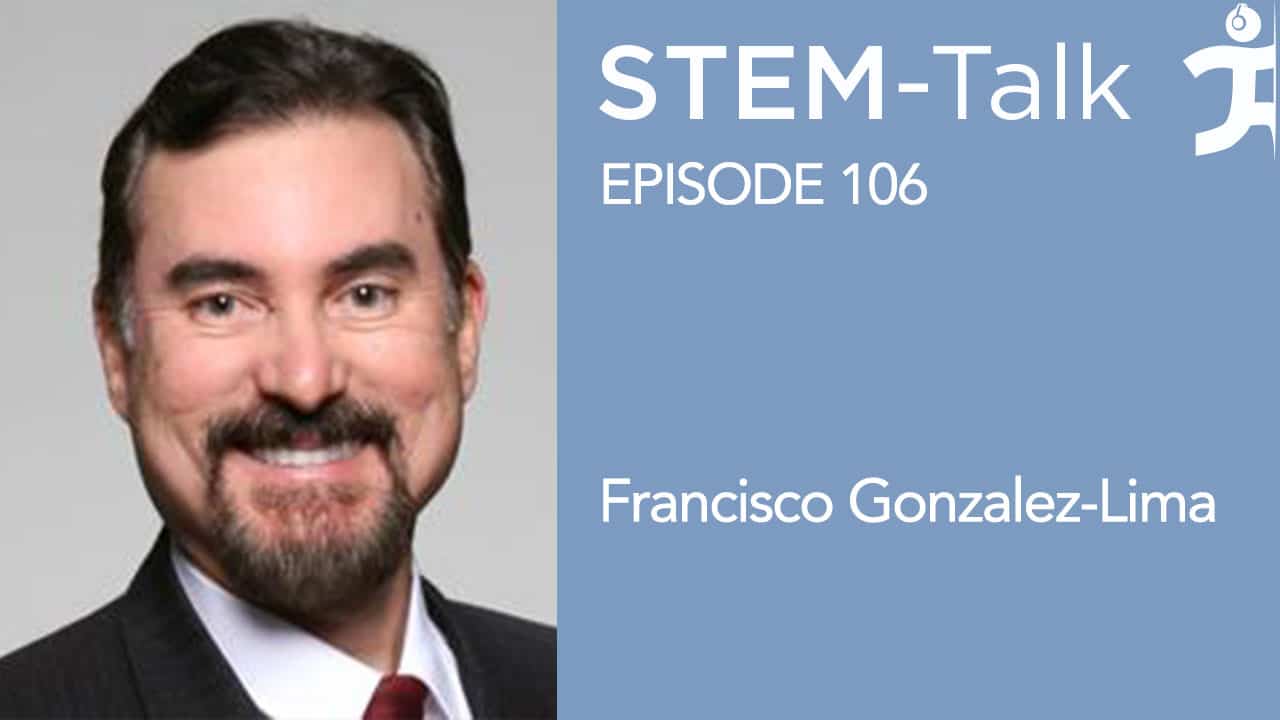STEM-Talk
Episode 106: Francisco Gonzalez-Lima talks about brain metabolic mapping and Alzheimer’s
// Apr 30, 2020

Our guest today is Dr. Francisco Gonzalez-Lima, a professor in the department of psychology, pharmacology and toxicology and the department of psychiatry at The University of Texas at Austin. He also is a professor at the university’s Institute for Neuroscience.
We covered so much ground in our discussion with Francisco that we have split his interview into two parts. Today’s interview focuses on Francisco’s fascinating background as a youth and Cuban expatriate as well as his early research into Alzheimer’s Disease and brain metabolic mapping. The second part of our interview, which follows in a few weeks, covers two interventions Francisco has been exploring with the aim of protecting people against neurodegeneration: low-dose methylene blue and the application of near-infrared light.
Francisco describes himself as a behavioral neuroscientist. He and his colleagues at the Gonzalez-Lima Lab are recognized as world leaders for their research on the relationship between brain energy metabolism, memory and neurobehavioral disorders.
Although he has spent most of his academic career at the University of Texas, Francisco has been a visiting neuroscientist in Germany, England, Canada and Spain, and has delivered more than 120 lectures around the world about his brain research. He also has contributed work to more than 300 scientific publications.
Over the years, Francisco’s brain research has focused on transcranial lasers, memory enhancement, neuroprotection and neurocognitive disorders. Current research in the Gonzalez-Lima laboratory focuses on the beneficial neurocognitive and emotional effects of noninvasive human brain stimulation in healthy, aging and mentally ill populations. This research primarily uses transcranial infrared laser stimulation and multimodal imaging.
Show notes:
[00:03:23] Dawn opens the interview mentioning that Francisco was born in Cuba where his father worked as a veterinarian. Dawn asks how Francisco’s family ended up leaving Cuba for Costa Rica when he was only ten years old. [00:04:25] Ken asks if it is true that Francisco got into a lot of fights as a child. [00:05:19] Francisco talks about his time as a child accompanying his veterinarian father to take care of cattle. [00:06:46] Dawn asks about Francisco’s time in college, two years of which he spent in Venezuela, and how he became known as an anti-communist student leader on campus. [00:08:18] Francisco tells the story of how he ended up going to school at Tulane University. [00:09:13] Dawn mentions that because Francisco’s father was a veterinarian, Francisco went to Tulane with the intent of working with animals. But after watching a professor dissect a human brain in class one day, Francisco changed his major. [00:10:17] Ken asks Francisco what lead him to decide to get a bachelor’s degree in biology and psychology. [00:11:49] Dawn asks about Francisco’s work with Nobel Prize winner Dr. Andrew Schalley during Francisco’s last summer at Tulane. [00:12:56] Francisco explains how he ended up of the University of Puerto Rico getting his doctorate in anatomy and neurobiology. [00:14:28] Dawn asks Francisco how learning about electrophysiology in his doctoral studies had an impact on him. [00:15:22] Francisco tells an interesting story of his doctoral dissertation. [00:16:21] Dawn asks about Francisco’s work with Dr. Walter Stiehl and the papers the two of them published in the European Journal of Pharmacology. [00:17:19] Dawn mentions that in 1981 Francisco met Henning Scheich, a German professor who had done a study involving the newly developed 2-deoxyglucose autoradiographic method. Francisco talks about why this neuroimaging approach to brain research fascinated him and led him to propose an ambitious collaborative research project with Dr. Scheich. [00:18:27] Dawn asks Francisco to talk about the work he did with Dr. Scheich to develop the human FDG (fluorodeoxyglucose) neuroimaging method, the first functional brain imaging technique to be used in humans. [00:19:58] Ken asks Francisco to explain the difference between functional studies and imaging studies. [00:21:18] Dawn asks about how Francisco met a group of Texas professors at a conference in Madrid, which lead him to join the new College of Medicine at Texas A&M. [00:22:35] Dawn mentions that in 1991, the University of Texas at Austin recruited Francisco to join its new Institute for Neuroscience and the Department of Psychology. [00:23:32] Dawn asks about the research Francisco and his colleagues are doing in the Gonzalez-Lima lab. [00:24:11] Ken asks what Francisco means when he describes himself as a behavioral neuroscientist. [00:25:13] Dawn asks about Francisco’s work on the neuroimaging effects of Pavlovian conditioning. [00:27:45] Dawn asks about the work Francisco did on habituation and sensitization. [00:29:57] Ken mentions that the brain is designed to handle large amounts of communication and computation. He asks if Francisco can elaborate on this concept. [00:31:10] Ken asks Francisco to describe the redundant structures of the brain. [00:33:35] Dawn turns the discussion to Alzheimer’s Disease, mentioning we still don’t fully grasp how the brain works. [00:35:12] Dawn mentions that in 2001 Francisco published a paper titled “Energy Hypometabolism in Posterior Cingulate Cortex of Alzheimer’s Patients: Superficial Laminar Cytochrome Oxidase Associated with Disease Duration.” The main histochemical finding of this study was that the decreased ration or the gravity of Alzheimer’s Disease was not related to any of the other things that were commonly mentioned like amyloid or tau proteins. Francisco gives an overview of this study and its significance. [00:39:32] Ken asks if ketone uptake in the brain diminishes some cases of Alzheimer’s or TBI. [00:41:18] Ken mentions Steven Cunane’s STEM-Talk interview and the work he has done work using neuroimaging to see if it’s possible to replace the energy lost from the glucose deficit with exogenous ketones. [00:42:11] Ken asks about the early signs of Alzheimer’s Disease. [00:45:27] Ken asks about the vascular hypothesis of Alzheimer’s Disease. [00:48:16] Dawn mentions that in the past few years, there has been a lot of coverage in the media about Early Onset Alzheimer’s Disease. She goes on to say that Francisco has pointed out in past interviews that EOAD is a rare genetic disease that is causally different than the most common geriatric dementia that is mistakenly called Alzheimer’s or late onset AD. Francisco discusses how this confusion has been an obstacle in advancing research. [00:52:24] Dawn gives a preview of part two of our interview with Francisco, which will upload in a few weeks.Links:






